Strategies for Effective Partnership Working
VerifiedAdded on 2020/10/04
|14
|4372
|145
AI Summary
This assignment delves into the world of health and social care, examining various strategies for effective partnership working. It discusses the significance of user involvement, social return on investment (SROI) measurement, and system approaches in improving outcomes and achieving long-term goals. The assignment draws on a range of sources, including academic books and journals, to provide a comprehensive overview of this critical topic.
Contribute Materials
Your contribution can guide someone’s learning journey. Share your
documents today.

Working in
Partnership
Partnership
Secure Best Marks with AI Grader
Need help grading? Try our AI Grader for instant feedback on your assignments.
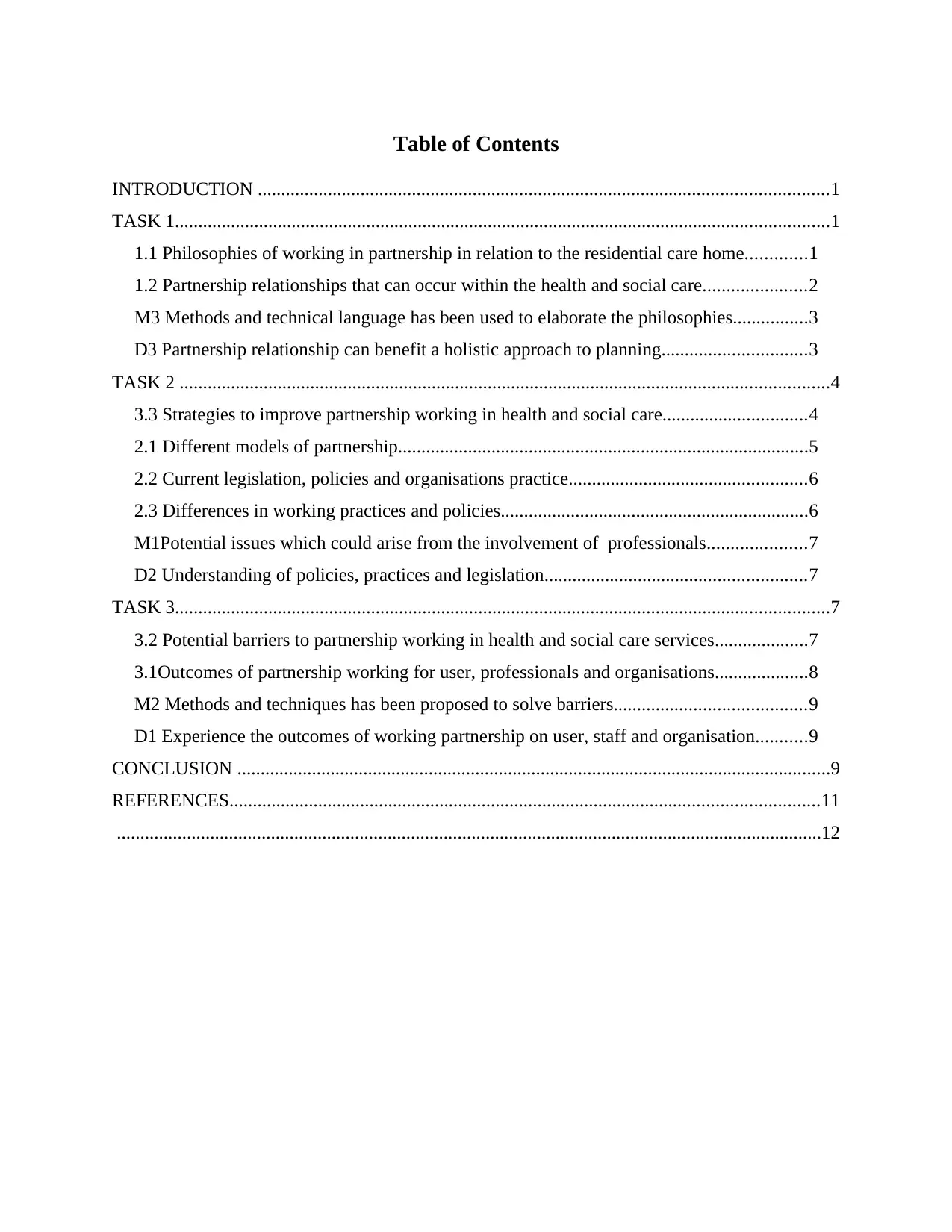
Table of Contents
INTRODUCTION ..........................................................................................................................1
TASK 1............................................................................................................................................1
1.1 Philosophies of working in partnership in relation to the residential care home.............1
1.2 Partnership relationships that can occur within the health and social care......................2
M3 Methods and technical language has been used to elaborate the philosophies................3
D3 Partnership relationship can benefit a holistic approach to planning...............................3
TASK 2 ...........................................................................................................................................4
3.3 Strategies to improve partnership working in health and social care...............................4
2.1 Different models of partnership........................................................................................5
2.2 Current legislation, policies and organisations practice...................................................6
2.3 Differences in working practices and policies..................................................................6
M1Potential issues which could arise from the involvement of professionals.....................7
D2 Understanding of policies, practices and legislation........................................................7
TASK 3............................................................................................................................................7
3.2 Potential barriers to partnership working in health and social care services....................7
3.1Outcomes of partnership working for user, professionals and organisations....................8
M2 Methods and techniques has been proposed to solve barriers.........................................9
D1 Experience the outcomes of working partnership on user, staff and organisation...........9
CONCLUSION ...............................................................................................................................9
REFERENCES..............................................................................................................................11
.......................................................................................................................................................12
INTRODUCTION ..........................................................................................................................1
TASK 1............................................................................................................................................1
1.1 Philosophies of working in partnership in relation to the residential care home.............1
1.2 Partnership relationships that can occur within the health and social care......................2
M3 Methods and technical language has been used to elaborate the philosophies................3
D3 Partnership relationship can benefit a holistic approach to planning...............................3
TASK 2 ...........................................................................................................................................4
3.3 Strategies to improve partnership working in health and social care...............................4
2.1 Different models of partnership........................................................................................5
2.2 Current legislation, policies and organisations practice...................................................6
2.3 Differences in working practices and policies..................................................................6
M1Potential issues which could arise from the involvement of professionals.....................7
D2 Understanding of policies, practices and legislation........................................................7
TASK 3............................................................................................................................................7
3.2 Potential barriers to partnership working in health and social care services....................7
3.1Outcomes of partnership working for user, professionals and organisations....................8
M2 Methods and techniques has been proposed to solve barriers.........................................9
D1 Experience the outcomes of working partnership on user, staff and organisation...........9
CONCLUSION ...............................................................................................................................9
REFERENCES..............................................................................................................................11
.......................................................................................................................................................12
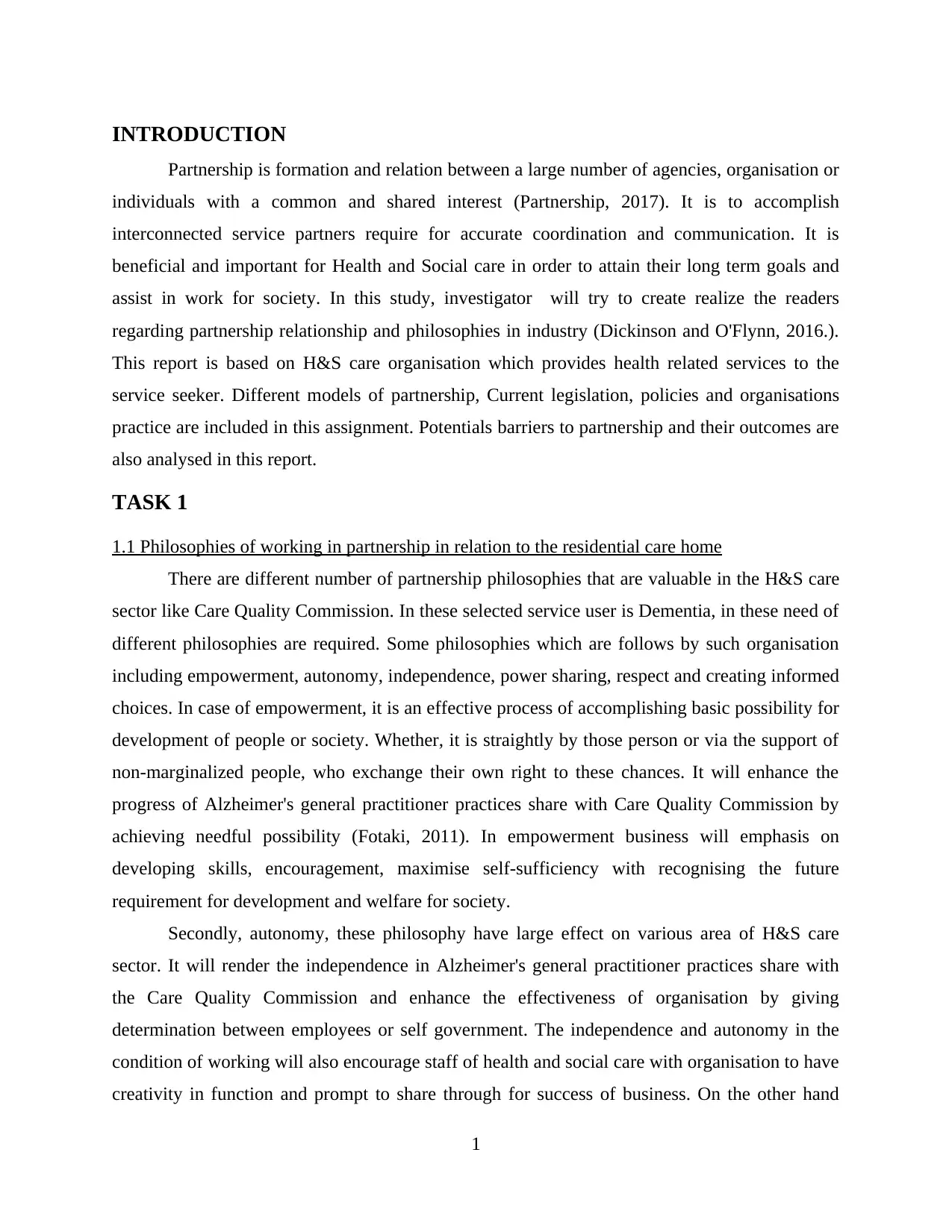
INTRODUCTION
Partnership is formation and relation between a large number of agencies, organisation or
individuals with a common and shared interest (Partnership, 2017). It is to accomplish
interconnected service partners require for accurate coordination and communication. It is
beneficial and important for Health and Social care in order to attain their long term goals and
assist in work for society. In this study, investigator will try to create realize the readers
regarding partnership relationship and philosophies in industry (Dickinson and O'Flynn, 2016.).
This report is based on H&S care organisation which provides health related services to the
service seeker. Different models of partnership, Current legislation, policies and organisations
practice are included in this assignment. Potentials barriers to partnership and their outcomes are
also analysed in this report.
TASK 1
1.1 Philosophies of working in partnership in relation to the residential care home
There are different number of partnership philosophies that are valuable in the H&S care
sector like Care Quality Commission. In these selected service user is Dementia, in these need of
different philosophies are required. Some philosophies which are follows by such organisation
including empowerment, autonomy, independence, power sharing, respect and creating informed
choices. In case of empowerment, it is an effective process of accomplishing basic possibility for
development of people or society. Whether, it is straightly by those person or via the support of
non-marginalized people, who exchange their own right to these chances. It will enhance the
progress of Alzheimer's general practitioner practices share with Care Quality Commission by
achieving needful possibility (Fotaki, 2011). In empowerment business will emphasis on
developing skills, encouragement, maximise self-sufficiency with recognising the future
requirement for development and welfare for society.
Secondly, autonomy, these philosophy have large effect on various area of H&S care
sector. It will render the independence in Alzheimer's general practitioner practices share with
the Care Quality Commission and enhance the effectiveness of organisation by giving
determination between employees or self government. The independence and autonomy in the
condition of working will also encourage staff of health and social care with organisation to have
creativity in function and prompt to share through for success of business. On the other hand
1
Partnership is formation and relation between a large number of agencies, organisation or
individuals with a common and shared interest (Partnership, 2017). It is to accomplish
interconnected service partners require for accurate coordination and communication. It is
beneficial and important for Health and Social care in order to attain their long term goals and
assist in work for society. In this study, investigator will try to create realize the readers
regarding partnership relationship and philosophies in industry (Dickinson and O'Flynn, 2016.).
This report is based on H&S care organisation which provides health related services to the
service seeker. Different models of partnership, Current legislation, policies and organisations
practice are included in this assignment. Potentials barriers to partnership and their outcomes are
also analysed in this report.
TASK 1
1.1 Philosophies of working in partnership in relation to the residential care home
There are different number of partnership philosophies that are valuable in the H&S care
sector like Care Quality Commission. In these selected service user is Dementia, in these need of
different philosophies are required. Some philosophies which are follows by such organisation
including empowerment, autonomy, independence, power sharing, respect and creating informed
choices. In case of empowerment, it is an effective process of accomplishing basic possibility for
development of people or society. Whether, it is straightly by those person or via the support of
non-marginalized people, who exchange their own right to these chances. It will enhance the
progress of Alzheimer's general practitioner practices share with Care Quality Commission by
achieving needful possibility (Fotaki, 2011). In empowerment business will emphasis on
developing skills, encouragement, maximise self-sufficiency with recognising the future
requirement for development and welfare for society.
Secondly, autonomy, these philosophy have large effect on various area of H&S care
sector. It will render the independence in Alzheimer's general practitioner practices share with
the Care Quality Commission and enhance the effectiveness of organisation by giving
determination between employees or self government. The independence and autonomy in the
condition of working will also encourage staff of health and social care with organisation to have
creativity in function and prompt to share through for success of business. On the other hand
1
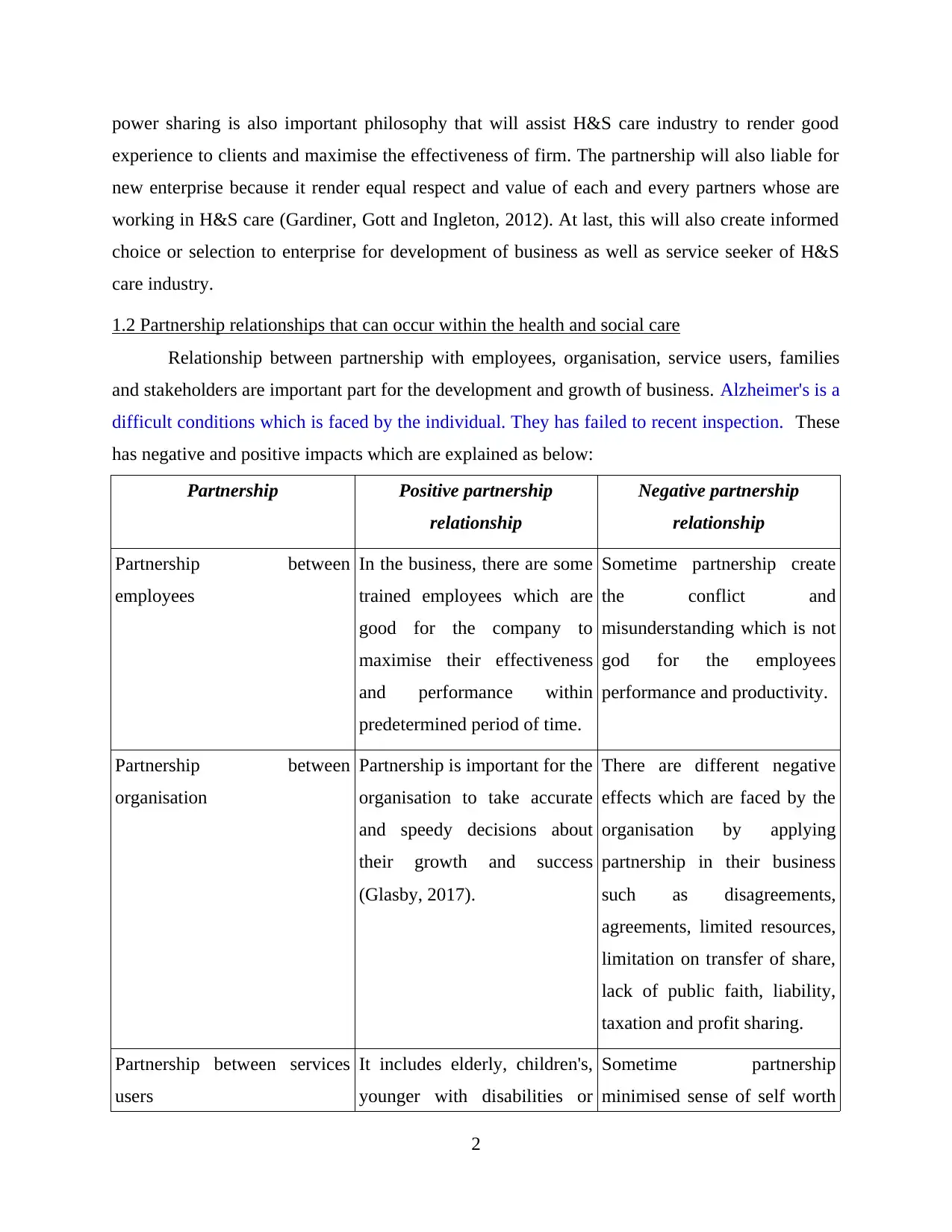
power sharing is also important philosophy that will assist H&S care industry to render good
experience to clients and maximise the effectiveness of firm. The partnership will also liable for
new enterprise because it render equal respect and value of each and every partners whose are
working in H&S care (Gardiner, Gott and Ingleton, 2012). At last, this will also create informed
choice or selection to enterprise for development of business as well as service seeker of H&S
care industry.
1.2 Partnership relationships that can occur within the health and social care
Relationship between partnership with employees, organisation, service users, families
and stakeholders are important part for the development and growth of business. Alzheimer's is a
difficult conditions which is faced by the individual. They has failed to recent inspection. These
has negative and positive impacts which are explained as below:
Partnership Positive partnership
relationship
Negative partnership
relationship
Partnership between
employees
In the business, there are some
trained employees which are
good for the company to
maximise their effectiveness
and performance within
predetermined period of time.
Sometime partnership create
the conflict and
misunderstanding which is not
god for the employees
performance and productivity.
Partnership between
organisation
Partnership is important for the
organisation to take accurate
and speedy decisions about
their growth and success
(Glasby, 2017).
There are different negative
effects which are faced by the
organisation by applying
partnership in their business
such as disagreements,
agreements, limited resources,
limitation on transfer of share,
lack of public faith, liability,
taxation and profit sharing.
Partnership between services
users
It includes elderly, children's,
younger with disabilities or
Sometime partnership
minimised sense of self worth
2
experience to clients and maximise the effectiveness of firm. The partnership will also liable for
new enterprise because it render equal respect and value of each and every partners whose are
working in H&S care (Gardiner, Gott and Ingleton, 2012). At last, this will also create informed
choice or selection to enterprise for development of business as well as service seeker of H&S
care industry.
1.2 Partnership relationships that can occur within the health and social care
Relationship between partnership with employees, organisation, service users, families
and stakeholders are important part for the development and growth of business. Alzheimer's is a
difficult conditions which is faced by the individual. They has failed to recent inspection. These
has negative and positive impacts which are explained as below:
Partnership Positive partnership
relationship
Negative partnership
relationship
Partnership between
employees
In the business, there are some
trained employees which are
good for the company to
maximise their effectiveness
and performance within
predetermined period of time.
Sometime partnership create
the conflict and
misunderstanding which is not
god for the employees
performance and productivity.
Partnership between
organisation
Partnership is important for the
organisation to take accurate
and speedy decisions about
their growth and success
(Glasby, 2017).
There are different negative
effects which are faced by the
organisation by applying
partnership in their business
such as disagreements,
agreements, limited resources,
limitation on transfer of share,
lack of public faith, liability,
taxation and profit sharing.
Partnership between services
users
It includes elderly, children's,
younger with disabilities or
Sometime partnership
minimised sense of self worth
2
Secure Best Marks with AI Grader
Need help grading? Try our AI Grader for instant feedback on your assignments.
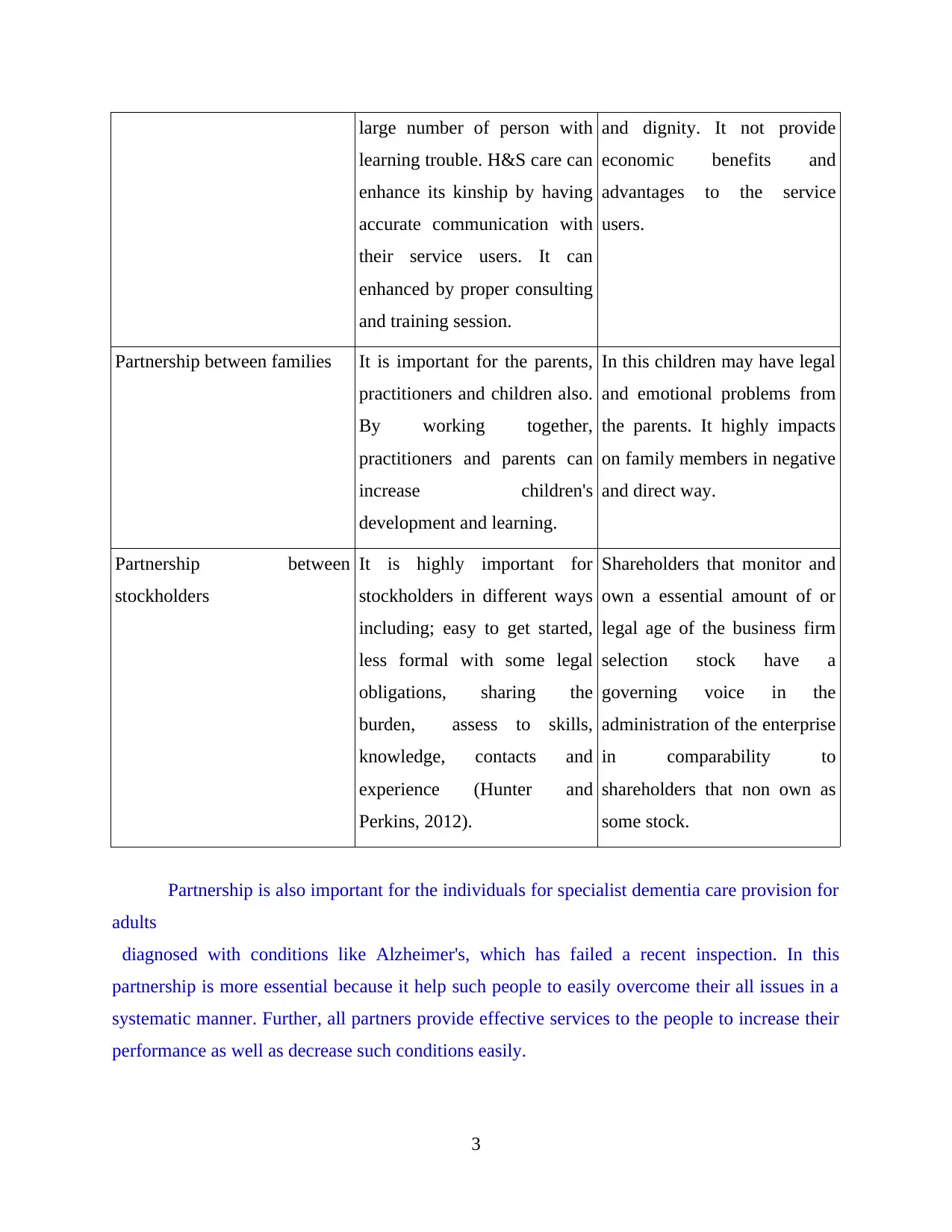
large number of person with
learning trouble. H&S care can
enhance its kinship by having
accurate communication with
their service users. It can
enhanced by proper consulting
and training session.
and dignity. It not provide
economic benefits and
advantages to the service
users.
Partnership between families It is important for the parents,
practitioners and children also.
By working together,
practitioners and parents can
increase children's
development and learning.
In this children may have legal
and emotional problems from
the parents. It highly impacts
on family members in negative
and direct way.
Partnership between
stockholders
It is highly important for
stockholders in different ways
including; easy to get started,
less formal with some legal
obligations, sharing the
burden, assess to skills,
knowledge, contacts and
experience (Hunter and
Perkins, 2012).
Shareholders that monitor and
own a essential amount of or
legal age of the business firm
selection stock have a
governing voice in the
administration of the enterprise
in comparability to
shareholders that non own as
some stock.
Partnership is also important for the individuals for specialist dementia care provision for
adults
diagnosed with conditions like Alzheimer's, which has failed a recent inspection. In this
partnership is more essential because it help such people to easily overcome their all issues in a
systematic manner. Further, all partners provide effective services to the people to increase their
performance as well as decrease such conditions easily.
3
learning trouble. H&S care can
enhance its kinship by having
accurate communication with
their service users. It can
enhanced by proper consulting
and training session.
and dignity. It not provide
economic benefits and
advantages to the service
users.
Partnership between families It is important for the parents,
practitioners and children also.
By working together,
practitioners and parents can
increase children's
development and learning.
In this children may have legal
and emotional problems from
the parents. It highly impacts
on family members in negative
and direct way.
Partnership between
stockholders
It is highly important for
stockholders in different ways
including; easy to get started,
less formal with some legal
obligations, sharing the
burden, assess to skills,
knowledge, contacts and
experience (Hunter and
Perkins, 2012).
Shareholders that monitor and
own a essential amount of or
legal age of the business firm
selection stock have a
governing voice in the
administration of the enterprise
in comparability to
shareholders that non own as
some stock.
Partnership is also important for the individuals for specialist dementia care provision for
adults
diagnosed with conditions like Alzheimer's, which has failed a recent inspection. In this
partnership is more essential because it help such people to easily overcome their all issues in a
systematic manner. Further, all partners provide effective services to the people to increase their
performance as well as decrease such conditions easily.
3
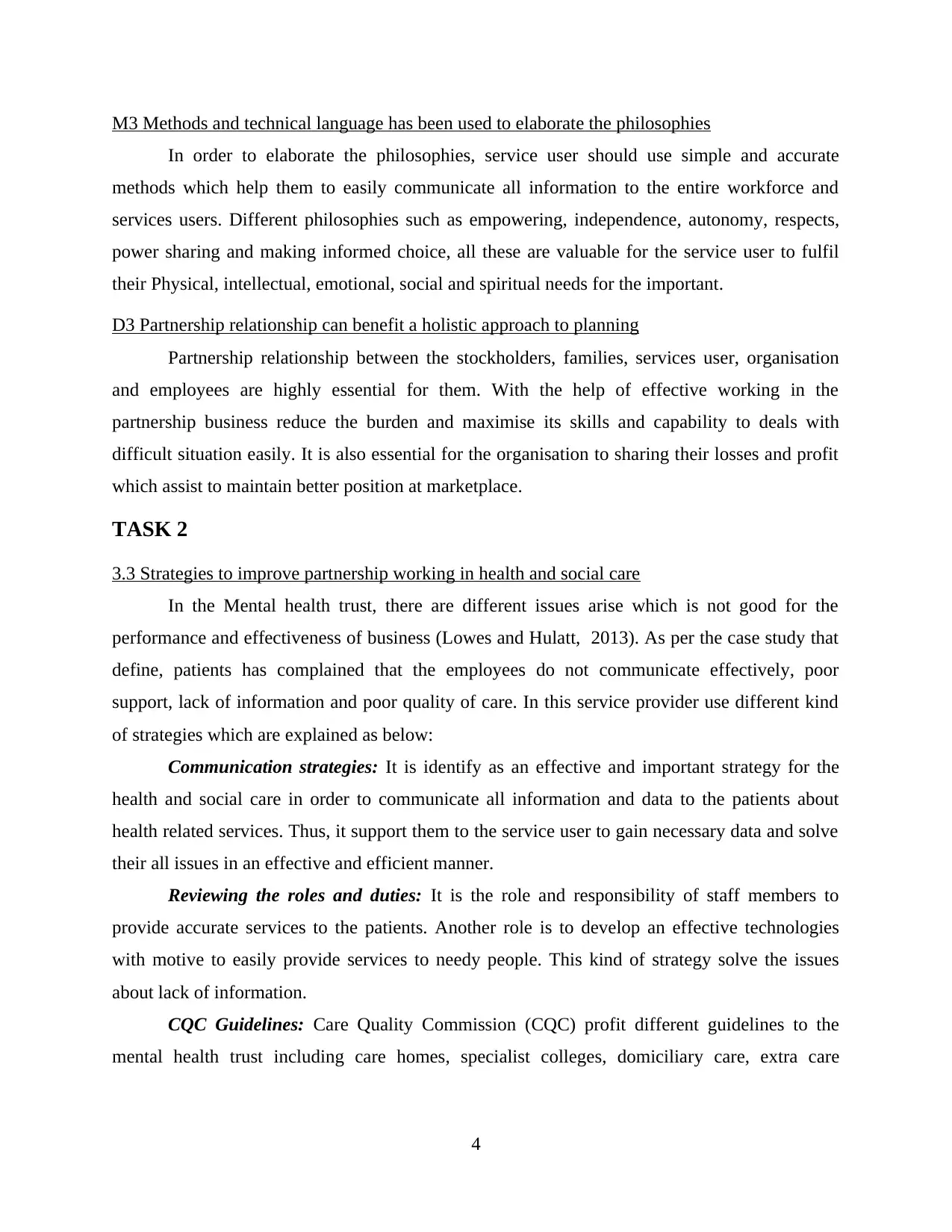
M3 Methods and technical language has been used to elaborate the philosophies
In order to elaborate the philosophies, service user should use simple and accurate
methods which help them to easily communicate all information to the entire workforce and
services users. Different philosophies such as empowering, independence, autonomy, respects,
power sharing and making informed choice, all these are valuable for the service user to fulfil
their Physical, intellectual, emotional, social and spiritual needs for the important.
D3 Partnership relationship can benefit a holistic approach to planning
Partnership relationship between the stockholders, families, services user, organisation
and employees are highly essential for them. With the help of effective working in the
partnership business reduce the burden and maximise its skills and capability to deals with
difficult situation easily. It is also essential for the organisation to sharing their losses and profit
which assist to maintain better position at marketplace.
TASK 2
3.3 Strategies to improve partnership working in health and social care
In the Mental health trust, there are different issues arise which is not good for the
performance and effectiveness of business (Lowes and Hulatt, 2013). As per the case study that
define, patients has complained that the employees do not communicate effectively, poor
support, lack of information and poor quality of care. In this service provider use different kind
of strategies which are explained as below:
Communication strategies: It is identify as an effective and important strategy for the
health and social care in order to communicate all information and data to the patients about
health related services. Thus, it support them to the service user to gain necessary data and solve
their all issues in an effective and efficient manner.
Reviewing the roles and duties: It is the role and responsibility of staff members to
provide accurate services to the patients. Another role is to develop an effective technologies
with motive to easily provide services to needy people. This kind of strategy solve the issues
about lack of information.
CQC Guidelines: Care Quality Commission (CQC) profit different guidelines to the
mental health trust including care homes, specialist colleges, domiciliary care, extra care
4
In order to elaborate the philosophies, service user should use simple and accurate
methods which help them to easily communicate all information to the entire workforce and
services users. Different philosophies such as empowering, independence, autonomy, respects,
power sharing and making informed choice, all these are valuable for the service user to fulfil
their Physical, intellectual, emotional, social and spiritual needs for the important.
D3 Partnership relationship can benefit a holistic approach to planning
Partnership relationship between the stockholders, families, services user, organisation
and employees are highly essential for them. With the help of effective working in the
partnership business reduce the burden and maximise its skills and capability to deals with
difficult situation easily. It is also essential for the organisation to sharing their losses and profit
which assist to maintain better position at marketplace.
TASK 2
3.3 Strategies to improve partnership working in health and social care
In the Mental health trust, there are different issues arise which is not good for the
performance and effectiveness of business (Lowes and Hulatt, 2013). As per the case study that
define, patients has complained that the employees do not communicate effectively, poor
support, lack of information and poor quality of care. In this service provider use different kind
of strategies which are explained as below:
Communication strategies: It is identify as an effective and important strategy for the
health and social care in order to communicate all information and data to the patients about
health related services. Thus, it support them to the service user to gain necessary data and solve
their all issues in an effective and efficient manner.
Reviewing the roles and duties: It is the role and responsibility of staff members to
provide accurate services to the patients. Another role is to develop an effective technologies
with motive to easily provide services to needy people. This kind of strategy solve the issues
about lack of information.
CQC Guidelines: Care Quality Commission (CQC) profit different guidelines to the
mental health trust including care homes, specialist colleges, domiciliary care, extra care
4
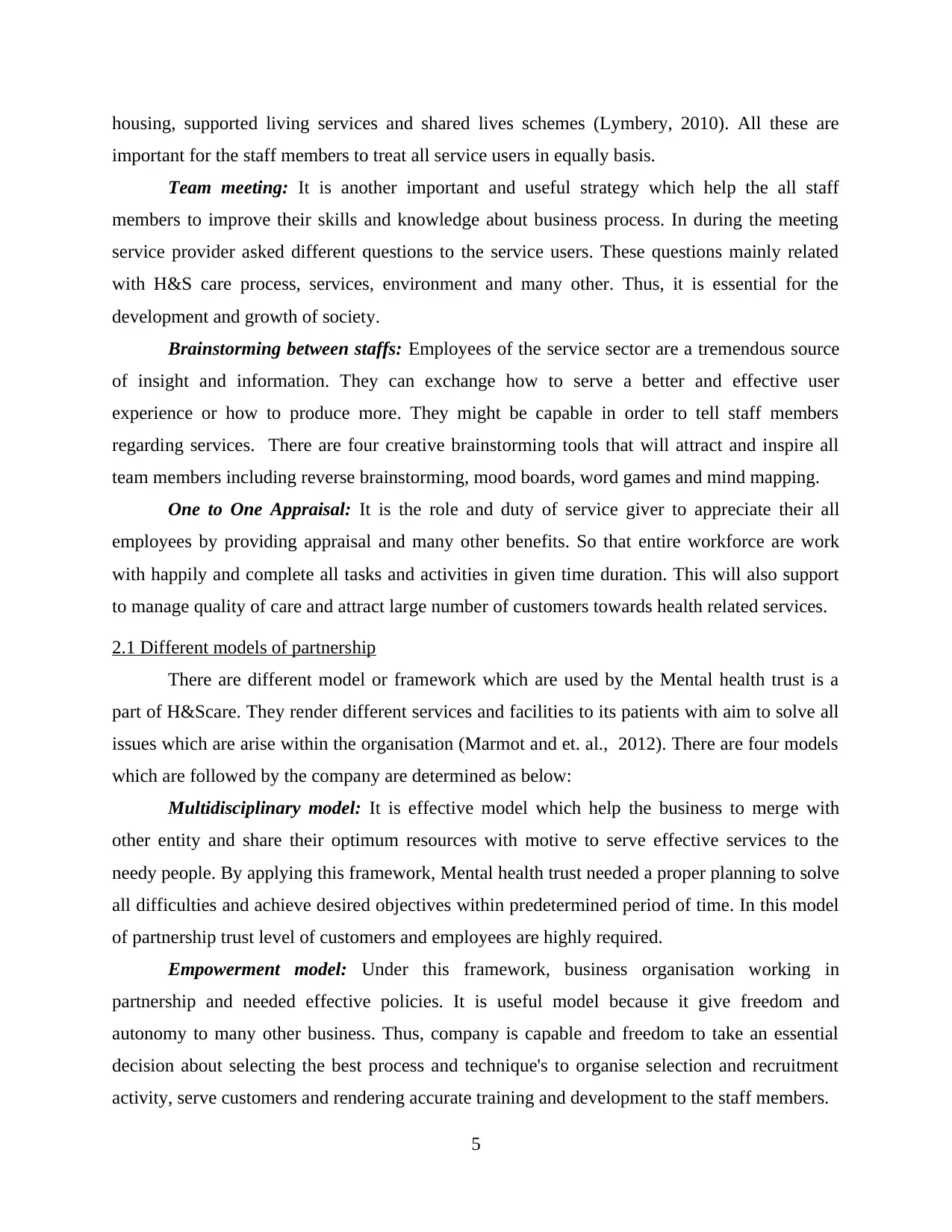
housing, supported living services and shared lives schemes (Lymbery, 2010). All these are
important for the staff members to treat all service users in equally basis.
Team meeting: It is another important and useful strategy which help the all staff
members to improve their skills and knowledge about business process. In during the meeting
service provider asked different questions to the service users. These questions mainly related
with H&S care process, services, environment and many other. Thus, it is essential for the
development and growth of society.
Brainstorming between staffs: Employees of the service sector are a tremendous source
of insight and information. They can exchange how to serve a better and effective user
experience or how to produce more. They might be capable in order to tell staff members
regarding services. There are four creative brainstorming tools that will attract and inspire all
team members including reverse brainstorming, mood boards, word games and mind mapping.
One to One Appraisal: It is the role and duty of service giver to appreciate their all
employees by providing appraisal and many other benefits. So that entire workforce are work
with happily and complete all tasks and activities in given time duration. This will also support
to manage quality of care and attract large number of customers towards health related services.
2.1 Different models of partnership
There are different model or framework which are used by the Mental health trust is a
part of H&Scare. They render different services and facilities to its patients with aim to solve all
issues which are arise within the organisation (Marmot and et. al., 2012). There are four models
which are followed by the company are determined as below:
Multidisciplinary model: It is effective model which help the business to merge with
other entity and share their optimum resources with motive to serve effective services to the
needy people. By applying this framework, Mental health trust needed a proper planning to solve
all difficulties and achieve desired objectives within predetermined period of time. In this model
of partnership trust level of customers and employees are highly required.
Empowerment model: Under this framework, business organisation working in
partnership and needed effective policies. It is useful model because it give freedom and
autonomy to many other business. Thus, company is capable and freedom to take an essential
decision about selecting the best process and technique's to organise selection and recruitment
activity, serve customers and rendering accurate training and development to the staff members.
5
important for the staff members to treat all service users in equally basis.
Team meeting: It is another important and useful strategy which help the all staff
members to improve their skills and knowledge about business process. In during the meeting
service provider asked different questions to the service users. These questions mainly related
with H&S care process, services, environment and many other. Thus, it is essential for the
development and growth of society.
Brainstorming between staffs: Employees of the service sector are a tremendous source
of insight and information. They can exchange how to serve a better and effective user
experience or how to produce more. They might be capable in order to tell staff members
regarding services. There are four creative brainstorming tools that will attract and inspire all
team members including reverse brainstorming, mood boards, word games and mind mapping.
One to One Appraisal: It is the role and duty of service giver to appreciate their all
employees by providing appraisal and many other benefits. So that entire workforce are work
with happily and complete all tasks and activities in given time duration. This will also support
to manage quality of care and attract large number of customers towards health related services.
2.1 Different models of partnership
There are different model or framework which are used by the Mental health trust is a
part of H&Scare. They render different services and facilities to its patients with aim to solve all
issues which are arise within the organisation (Marmot and et. al., 2012). There are four models
which are followed by the company are determined as below:
Multidisciplinary model: It is effective model which help the business to merge with
other entity and share their optimum resources with motive to serve effective services to the
needy people. By applying this framework, Mental health trust needed a proper planning to solve
all difficulties and achieve desired objectives within predetermined period of time. In this model
of partnership trust level of customers and employees are highly required.
Empowerment model: Under this framework, business organisation working in
partnership and needed effective policies. It is useful model because it give freedom and
autonomy to many other business. Thus, company is capable and freedom to take an essential
decision about selecting the best process and technique's to organise selection and recruitment
activity, serve customers and rendering accurate training and development to the staff members.
5
Paraphrase This Document
Need a fresh take? Get an instant paraphrase of this document with our AI Paraphraser
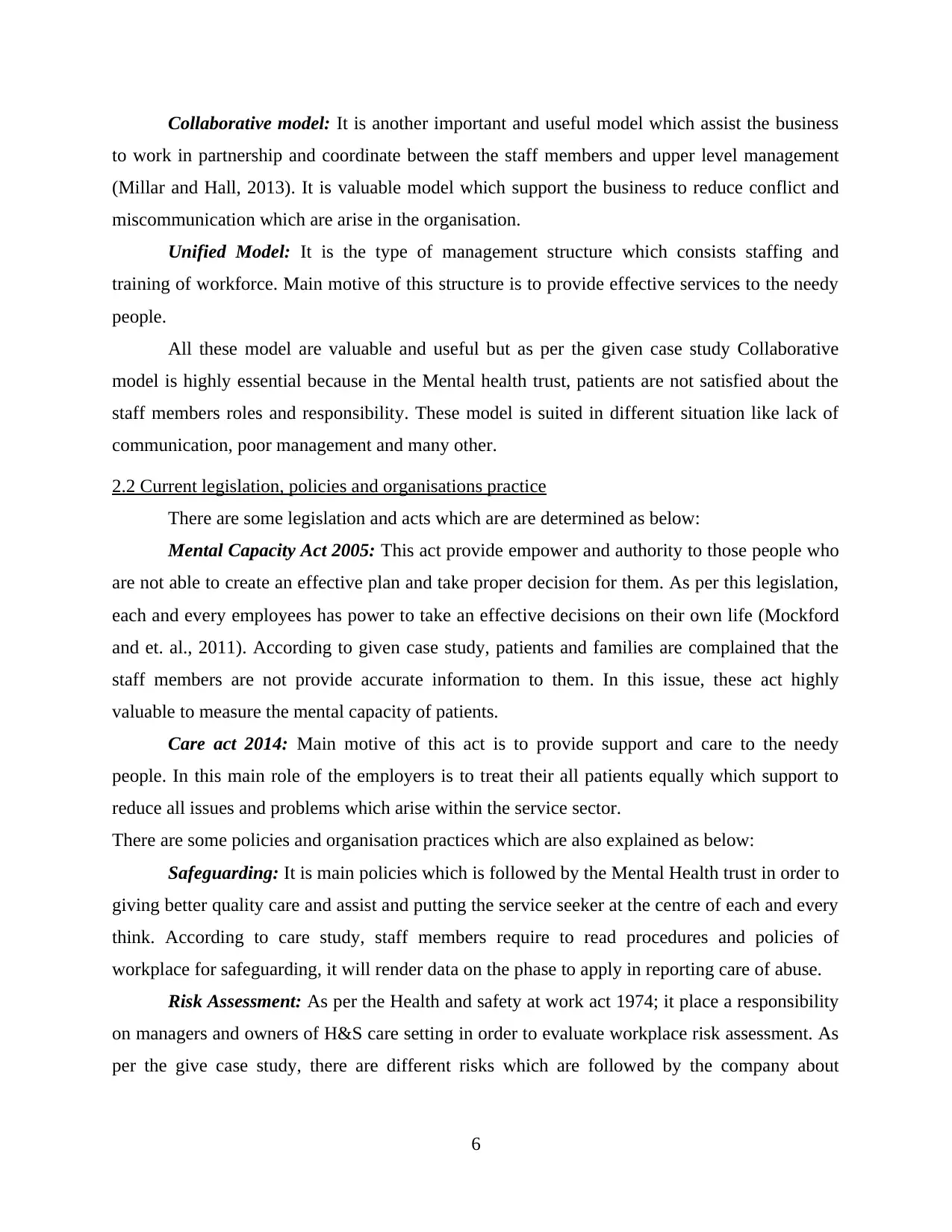
Collaborative model: It is another important and useful model which assist the business
to work in partnership and coordinate between the staff members and upper level management
(Millar and Hall, 2013). It is valuable model which support the business to reduce conflict and
miscommunication which are arise in the organisation.
Unified Model: It is the type of management structure which consists staffing and
training of workforce. Main motive of this structure is to provide effective services to the needy
people.
All these model are valuable and useful but as per the given case study Collaborative
model is highly essential because in the Mental health trust, patients are not satisfied about the
staff members roles and responsibility. These model is suited in different situation like lack of
communication, poor management and many other.
2.2 Current legislation, policies and organisations practice
There are some legislation and acts which are are determined as below:
Mental Capacity Act 2005: This act provide empower and authority to those people who
are not able to create an effective plan and take proper decision for them. As per this legislation,
each and every employees has power to take an effective decisions on their own life (Mockford
and et. al., 2011). According to given case study, patients and families are complained that the
staff members are not provide accurate information to them. In this issue, these act highly
valuable to measure the mental capacity of patients.
Care act 2014: Main motive of this act is to provide support and care to the needy
people. In this main role of the employers is to treat their all patients equally which support to
reduce all issues and problems which arise within the service sector.
There are some policies and organisation practices which are also explained as below:
Safeguarding: It is main policies which is followed by the Mental Health trust in order to
giving better quality care and assist and putting the service seeker at the centre of each and every
think. According to care study, staff members require to read procedures and policies of
workplace for safeguarding, it will render data on the phase to apply in reporting care of abuse.
Risk Assessment: As per the Health and safety at work act 1974; it place a responsibility
on managers and owners of H&S care setting in order to evaluate workplace risk assessment. As
per the give case study, there are different risks which are followed by the company about
6
to work in partnership and coordinate between the staff members and upper level management
(Millar and Hall, 2013). It is valuable model which support the business to reduce conflict and
miscommunication which are arise in the organisation.
Unified Model: It is the type of management structure which consists staffing and
training of workforce. Main motive of this structure is to provide effective services to the needy
people.
All these model are valuable and useful but as per the given case study Collaborative
model is highly essential because in the Mental health trust, patients are not satisfied about the
staff members roles and responsibility. These model is suited in different situation like lack of
communication, poor management and many other.
2.2 Current legislation, policies and organisations practice
There are some legislation and acts which are are determined as below:
Mental Capacity Act 2005: This act provide empower and authority to those people who
are not able to create an effective plan and take proper decision for them. As per this legislation,
each and every employees has power to take an effective decisions on their own life (Mockford
and et. al., 2011). According to given case study, patients and families are complained that the
staff members are not provide accurate information to them. In this issue, these act highly
valuable to measure the mental capacity of patients.
Care act 2014: Main motive of this act is to provide support and care to the needy
people. In this main role of the employers is to treat their all patients equally which support to
reduce all issues and problems which arise within the service sector.
There are some policies and organisation practices which are also explained as below:
Safeguarding: It is main policies which is followed by the Mental Health trust in order to
giving better quality care and assist and putting the service seeker at the centre of each and every
think. According to care study, staff members require to read procedures and policies of
workplace for safeguarding, it will render data on the phase to apply in reporting care of abuse.
Risk Assessment: As per the Health and safety at work act 1974; it place a responsibility
on managers and owners of H&S care setting in order to evaluate workplace risk assessment. As
per the give case study, there are different risks which are followed by the company about
6
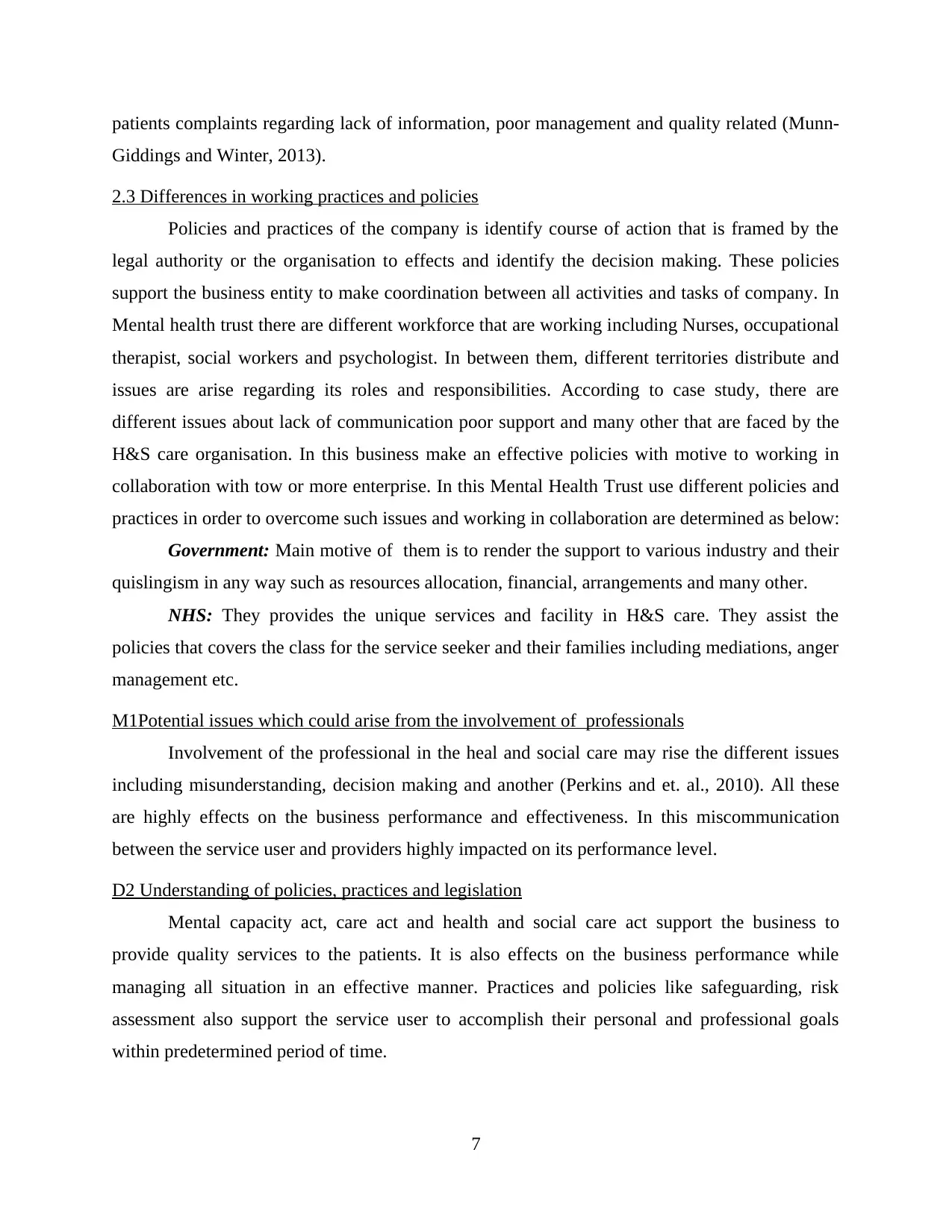
patients complaints regarding lack of information, poor management and quality related (Munn-
Giddings and Winter, 2013).
2.3 Differences in working practices and policies
Policies and practices of the company is identify course of action that is framed by the
legal authority or the organisation to effects and identify the decision making. These policies
support the business entity to make coordination between all activities and tasks of company. In
Mental health trust there are different workforce that are working including Nurses, occupational
therapist, social workers and psychologist. In between them, different territories distribute and
issues are arise regarding its roles and responsibilities. According to case study, there are
different issues about lack of communication poor support and many other that are faced by the
H&S care organisation. In this business make an effective policies with motive to working in
collaboration with tow or more enterprise. In this Mental Health Trust use different policies and
practices in order to overcome such issues and working in collaboration are determined as below:
Government: Main motive of them is to render the support to various industry and their
quislingism in any way such as resources allocation, financial, arrangements and many other.
NHS: They provides the unique services and facility in H&S care. They assist the
policies that covers the class for the service seeker and their families including mediations, anger
management etc.
M1Potential issues which could arise from the involvement of professionals
Involvement of the professional in the heal and social care may rise the different issues
including misunderstanding, decision making and another (Perkins and et. al., 2010). All these
are highly effects on the business performance and effectiveness. In this miscommunication
between the service user and providers highly impacted on its performance level.
D2 Understanding of policies, practices and legislation
Mental capacity act, care act and health and social care act support the business to
provide quality services to the patients. It is also effects on the business performance while
managing all situation in an effective manner. Practices and policies like safeguarding, risk
assessment also support the service user to accomplish their personal and professional goals
within predetermined period of time.
7
Giddings and Winter, 2013).
2.3 Differences in working practices and policies
Policies and practices of the company is identify course of action that is framed by the
legal authority or the organisation to effects and identify the decision making. These policies
support the business entity to make coordination between all activities and tasks of company. In
Mental health trust there are different workforce that are working including Nurses, occupational
therapist, social workers and psychologist. In between them, different territories distribute and
issues are arise regarding its roles and responsibilities. According to case study, there are
different issues about lack of communication poor support and many other that are faced by the
H&S care organisation. In this business make an effective policies with motive to working in
collaboration with tow or more enterprise. In this Mental Health Trust use different policies and
practices in order to overcome such issues and working in collaboration are determined as below:
Government: Main motive of them is to render the support to various industry and their
quislingism in any way such as resources allocation, financial, arrangements and many other.
NHS: They provides the unique services and facility in H&S care. They assist the
policies that covers the class for the service seeker and their families including mediations, anger
management etc.
M1Potential issues which could arise from the involvement of professionals
Involvement of the professional in the heal and social care may rise the different issues
including misunderstanding, decision making and another (Perkins and et. al., 2010). All these
are highly effects on the business performance and effectiveness. In this miscommunication
between the service user and providers highly impacted on its performance level.
D2 Understanding of policies, practices and legislation
Mental capacity act, care act and health and social care act support the business to
provide quality services to the patients. It is also effects on the business performance while
managing all situation in an effective manner. Practices and policies like safeguarding, risk
assessment also support the service user to accomplish their personal and professional goals
within predetermined period of time.
7
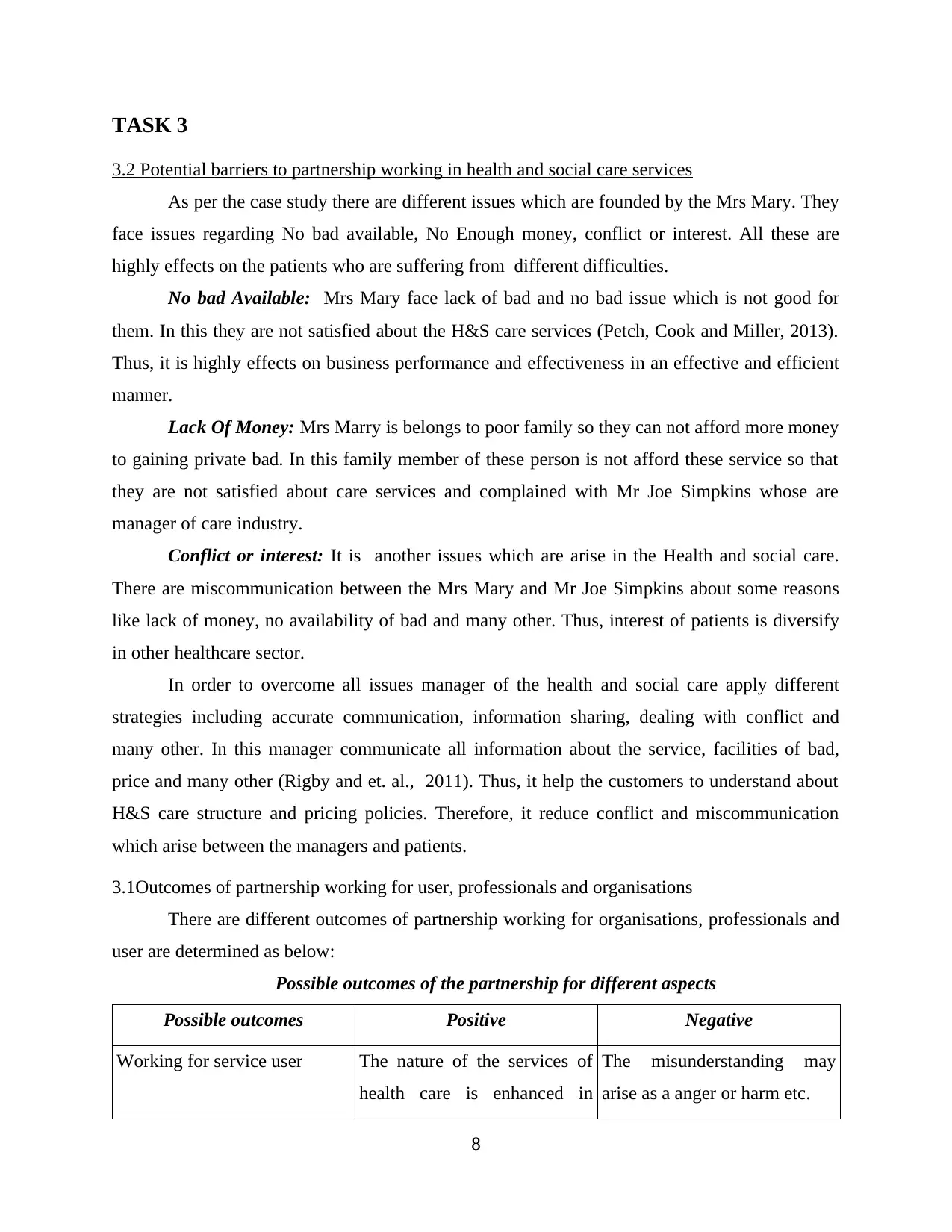
TASK 3
3.2 Potential barriers to partnership working in health and social care services
As per the case study there are different issues which are founded by the Mrs Mary. They
face issues regarding No bad available, No Enough money, conflict or interest. All these are
highly effects on the patients who are suffering from different difficulties.
No bad Available: Mrs Mary face lack of bad and no bad issue which is not good for
them. In this they are not satisfied about the H&S care services (Petch, Cook and Miller, 2013).
Thus, it is highly effects on business performance and effectiveness in an effective and efficient
manner.
Lack Of Money: Mrs Marry is belongs to poor family so they can not afford more money
to gaining private bad. In this family member of these person is not afford these service so that
they are not satisfied about care services and complained with Mr Joe Simpkins whose are
manager of care industry.
Conflict or interest: It is another issues which are arise in the Health and social care.
There are miscommunication between the Mrs Mary and Mr Joe Simpkins about some reasons
like lack of money, no availability of bad and many other. Thus, interest of patients is diversify
in other healthcare sector.
In order to overcome all issues manager of the health and social care apply different
strategies including accurate communication, information sharing, dealing with conflict and
many other. In this manager communicate all information about the service, facilities of bad,
price and many other (Rigby and et. al., 2011). Thus, it help the customers to understand about
H&S care structure and pricing policies. Therefore, it reduce conflict and miscommunication
which arise between the managers and patients.
3.1Outcomes of partnership working for user, professionals and organisations
There are different outcomes of partnership working for organisations, professionals and
user are determined as below:
Possible outcomes of the partnership for different aspects
Possible outcomes Positive Negative
Working for service user The nature of the services of
health care is enhanced in
The misunderstanding may
arise as a anger or harm etc.
8
3.2 Potential barriers to partnership working in health and social care services
As per the case study there are different issues which are founded by the Mrs Mary. They
face issues regarding No bad available, No Enough money, conflict or interest. All these are
highly effects on the patients who are suffering from different difficulties.
No bad Available: Mrs Mary face lack of bad and no bad issue which is not good for
them. In this they are not satisfied about the H&S care services (Petch, Cook and Miller, 2013).
Thus, it is highly effects on business performance and effectiveness in an effective and efficient
manner.
Lack Of Money: Mrs Marry is belongs to poor family so they can not afford more money
to gaining private bad. In this family member of these person is not afford these service so that
they are not satisfied about care services and complained with Mr Joe Simpkins whose are
manager of care industry.
Conflict or interest: It is another issues which are arise in the Health and social care.
There are miscommunication between the Mrs Mary and Mr Joe Simpkins about some reasons
like lack of money, no availability of bad and many other. Thus, interest of patients is diversify
in other healthcare sector.
In order to overcome all issues manager of the health and social care apply different
strategies including accurate communication, information sharing, dealing with conflict and
many other. In this manager communicate all information about the service, facilities of bad,
price and many other (Rigby and et. al., 2011). Thus, it help the customers to understand about
H&S care structure and pricing policies. Therefore, it reduce conflict and miscommunication
which arise between the managers and patients.
3.1Outcomes of partnership working for user, professionals and organisations
There are different outcomes of partnership working for organisations, professionals and
user are determined as below:
Possible outcomes of the partnership for different aspects
Possible outcomes Positive Negative
Working for service user The nature of the services of
health care is enhanced in
The misunderstanding may
arise as a anger or harm etc.
8
Secure Best Marks with AI Grader
Need help grading? Try our AI Grader for instant feedback on your assignments.
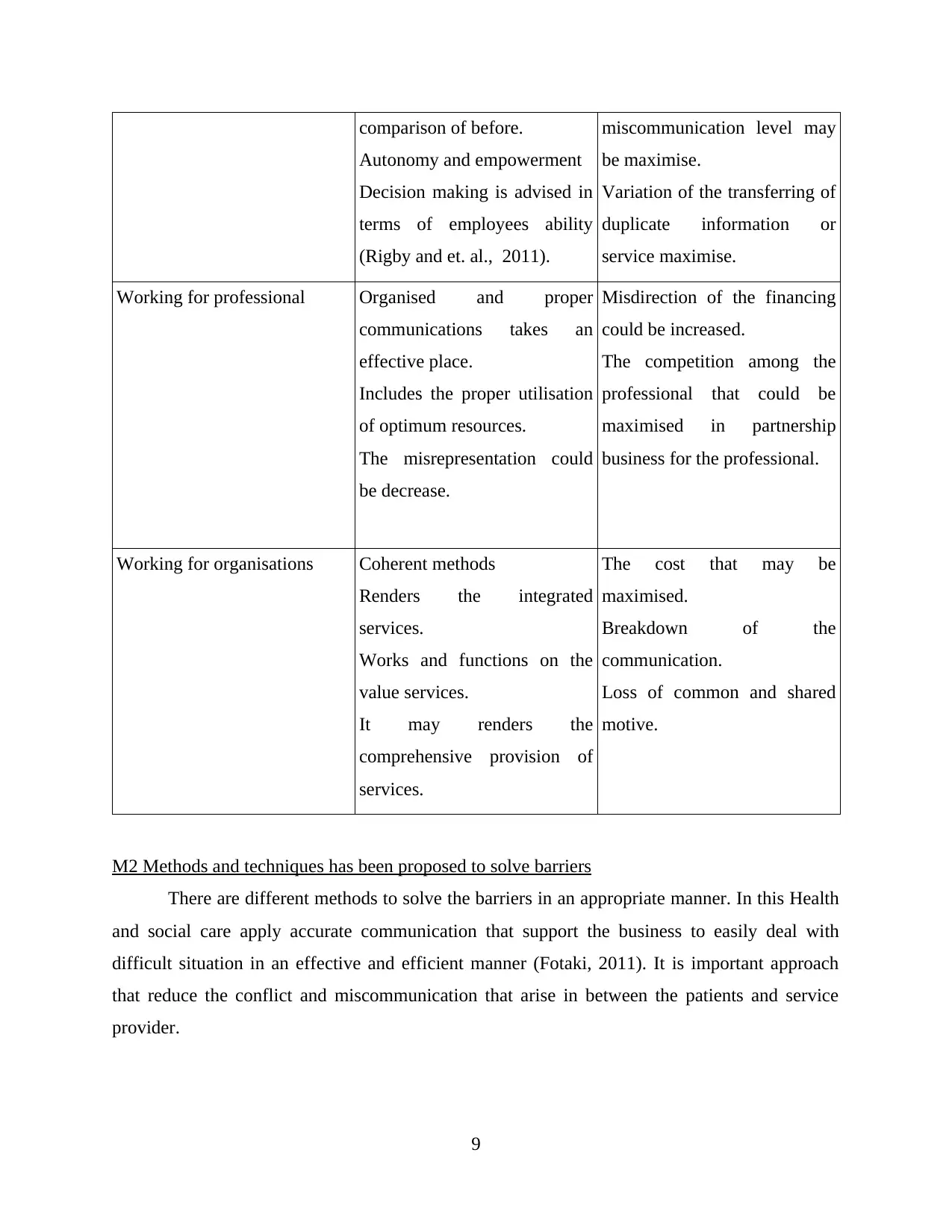
comparison of before.
Autonomy and empowerment
Decision making is advised in
terms of employees ability
(Rigby and et. al., 2011).
miscommunication level may
be maximise.
Variation of the transferring of
duplicate information or
service maximise.
Working for professional Organised and proper
communications takes an
effective place.
Includes the proper utilisation
of optimum resources.
The misrepresentation could
be decrease.
Misdirection of the financing
could be increased.
The competition among the
professional that could be
maximised in partnership
business for the professional.
Working for organisations Coherent methods
Renders the integrated
services.
Works and functions on the
value services.
It may renders the
comprehensive provision of
services.
The cost that may be
maximised.
Breakdown of the
communication.
Loss of common and shared
motive.
M2 Methods and techniques has been proposed to solve barriers
There are different methods to solve the barriers in an appropriate manner. In this Health
and social care apply accurate communication that support the business to easily deal with
difficult situation in an effective and efficient manner (Fotaki, 2011). It is important approach
that reduce the conflict and miscommunication that arise in between the patients and service
provider.
9
Autonomy and empowerment
Decision making is advised in
terms of employees ability
(Rigby and et. al., 2011).
miscommunication level may
be maximise.
Variation of the transferring of
duplicate information or
service maximise.
Working for professional Organised and proper
communications takes an
effective place.
Includes the proper utilisation
of optimum resources.
The misrepresentation could
be decrease.
Misdirection of the financing
could be increased.
The competition among the
professional that could be
maximised in partnership
business for the professional.
Working for organisations Coherent methods
Renders the integrated
services.
Works and functions on the
value services.
It may renders the
comprehensive provision of
services.
The cost that may be
maximised.
Breakdown of the
communication.
Loss of common and shared
motive.
M2 Methods and techniques has been proposed to solve barriers
There are different methods to solve the barriers in an appropriate manner. In this Health
and social care apply accurate communication that support the business to easily deal with
difficult situation in an effective and efficient manner (Fotaki, 2011). It is important approach
that reduce the conflict and miscommunication that arise in between the patients and service
provider.
9
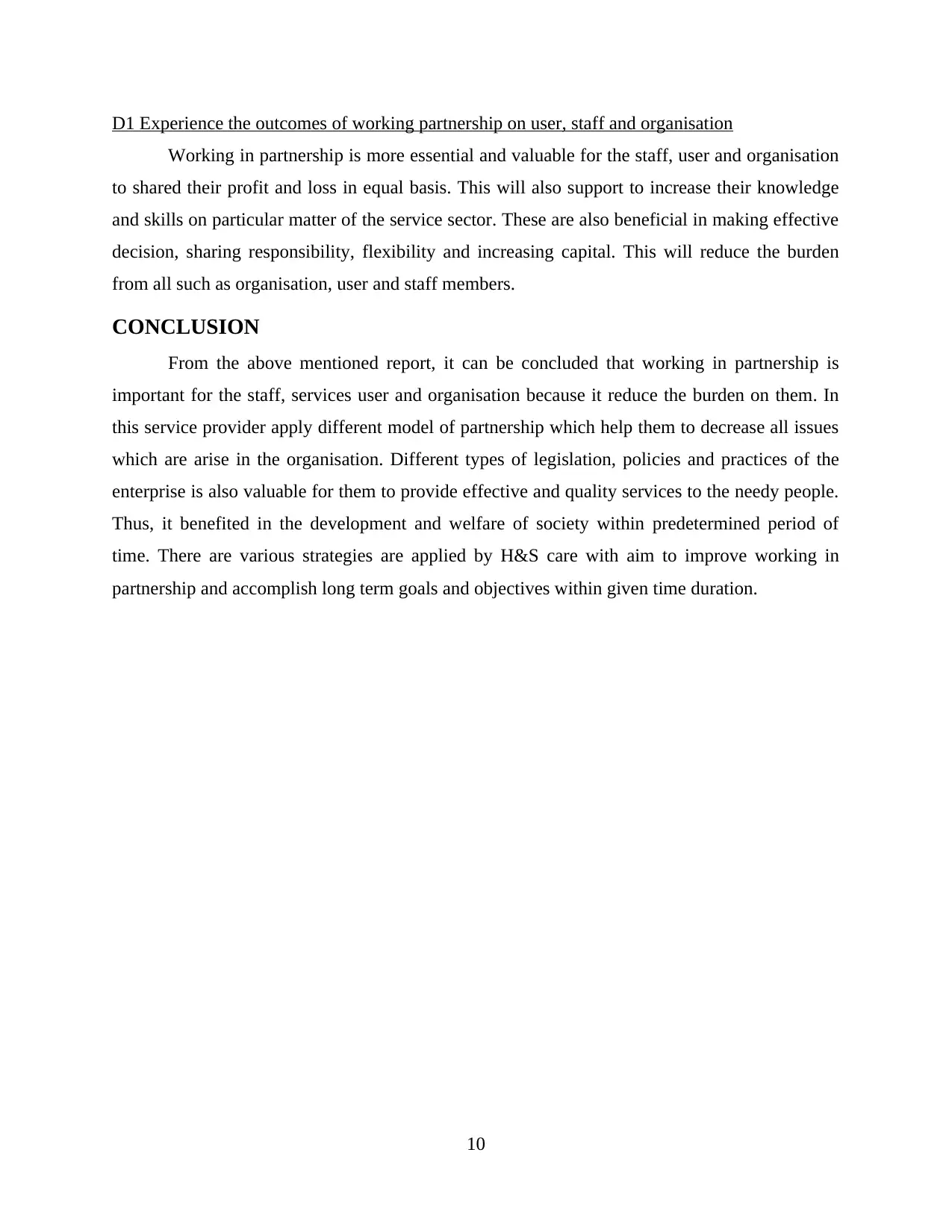
D1 Experience the outcomes of working partnership on user, staff and organisation
Working in partnership is more essential and valuable for the staff, user and organisation
to shared their profit and loss in equal basis. This will also support to increase their knowledge
and skills on particular matter of the service sector. These are also beneficial in making effective
decision, sharing responsibility, flexibility and increasing capital. This will reduce the burden
from all such as organisation, user and staff members.
CONCLUSION
From the above mentioned report, it can be concluded that working in partnership is
important for the staff, services user and organisation because it reduce the burden on them. In
this service provider apply different model of partnership which help them to decrease all issues
which are arise in the organisation. Different types of legislation, policies and practices of the
enterprise is also valuable for them to provide effective and quality services to the needy people.
Thus, it benefited in the development and welfare of society within predetermined period of
time. There are various strategies are applied by H&S care with aim to improve working in
partnership and accomplish long term goals and objectives within given time duration.
10
Working in partnership is more essential and valuable for the staff, user and organisation
to shared their profit and loss in equal basis. This will also support to increase their knowledge
and skills on particular matter of the service sector. These are also beneficial in making effective
decision, sharing responsibility, flexibility and increasing capital. This will reduce the burden
from all such as organisation, user and staff members.
CONCLUSION
From the above mentioned report, it can be concluded that working in partnership is
important for the staff, services user and organisation because it reduce the burden on them. In
this service provider apply different model of partnership which help them to decrease all issues
which are arise in the organisation. Different types of legislation, policies and practices of the
enterprise is also valuable for them to provide effective and quality services to the needy people.
Thus, it benefited in the development and welfare of society within predetermined period of
time. There are various strategies are applied by H&S care with aim to improve working in
partnership and accomplish long term goals and objectives within given time duration.
10
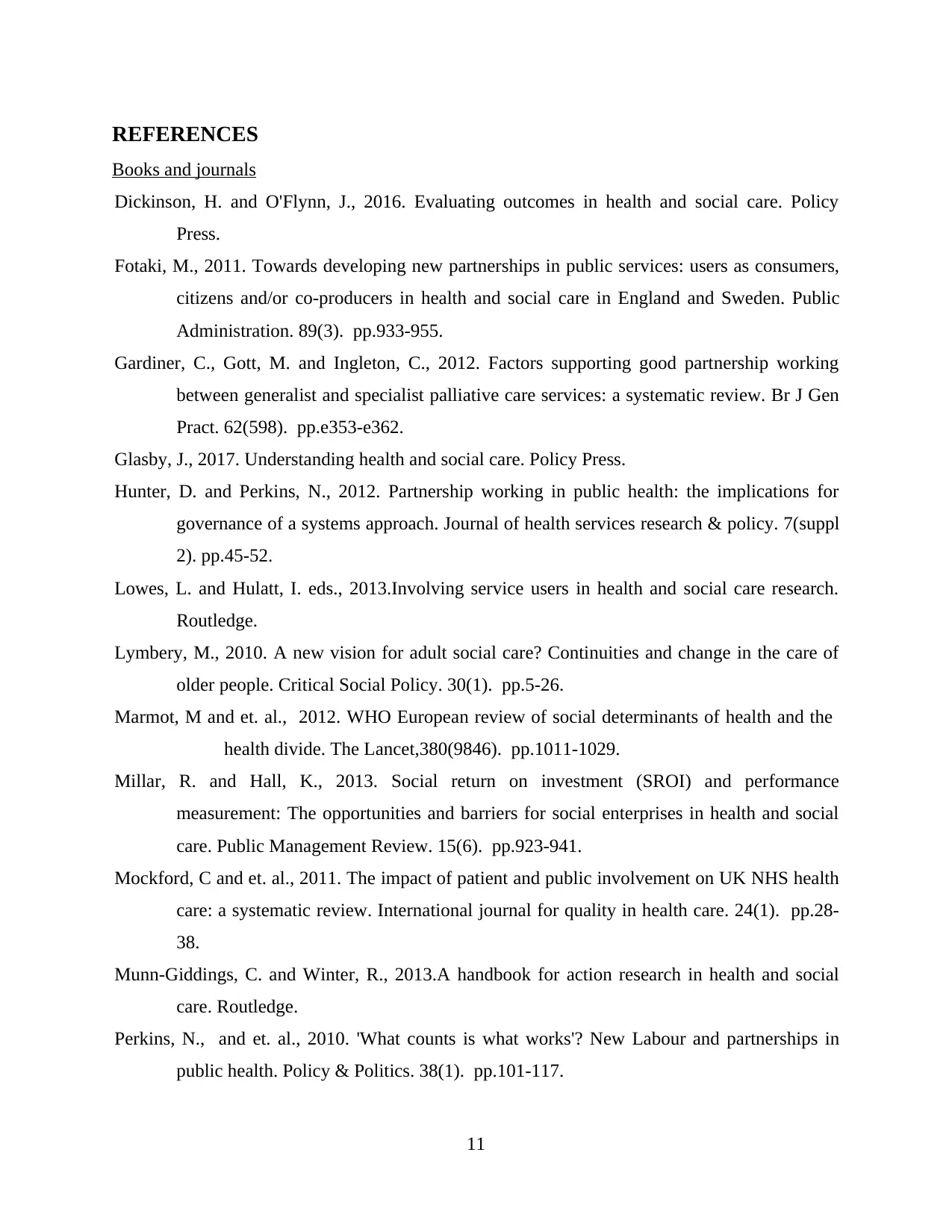
REFERENCES
Books and journals
Dickinson, H. and O'Flynn, J., 2016. Evaluating outcomes in health and social care. Policy
Press.
Fotaki, M., 2011. Towards developing new partnerships in public services: users as consumers,
citizens and/or co‐producers in health and social care in England and Sweden. Public
Administration. 89(3). pp.933-955.
Gardiner, C., Gott, M. and Ingleton, C., 2012. Factors supporting good partnership working
between generalist and specialist palliative care services: a systematic review. Br J Gen
Pract. 62(598). pp.e353-e362.
Glasby, J., 2017. Understanding health and social care. Policy Press.
Hunter, D. and Perkins, N., 2012. Partnership working in public health: the implications for
governance of a systems approach. Journal of health services research & policy. 7(suppl
2). pp.45-52.
Lowes, L. and Hulatt, I. eds., 2013.Involving service users in health and social care research.
Routledge.
Lymbery, M., 2010. A new vision for adult social care? Continuities and change in the care of
older people. Critical Social Policy. 30(1). pp.5-26.
Marmot, M and et. al., 2012. WHO European review of social determinants of health and the
health divide. The Lancet,380(9846). pp.1011-1029.
Millar, R. and Hall, K., 2013. Social return on investment (SROI) and performance
measurement: The opportunities and barriers for social enterprises in health and social
care. Public Management Review. 15(6). pp.923-941.
Mockford, C and et. al., 2011. The impact of patient and public involvement on UK NHS health
care: a systematic review. International journal for quality in health care. 24(1). pp.28-
38.
Munn-Giddings, C. and Winter, R., 2013.A handbook for action research in health and social
care. Routledge.
Perkins, N., and et. al., 2010. 'What counts is what works'? New Labour and partnerships in
public health. Policy & Politics. 38(1). pp.101-117.
11
Books and journals
Dickinson, H. and O'Flynn, J., 2016. Evaluating outcomes in health and social care. Policy
Press.
Fotaki, M., 2011. Towards developing new partnerships in public services: users as consumers,
citizens and/or co‐producers in health and social care in England and Sweden. Public
Administration. 89(3). pp.933-955.
Gardiner, C., Gott, M. and Ingleton, C., 2012. Factors supporting good partnership working
between generalist and specialist palliative care services: a systematic review. Br J Gen
Pract. 62(598). pp.e353-e362.
Glasby, J., 2017. Understanding health and social care. Policy Press.
Hunter, D. and Perkins, N., 2012. Partnership working in public health: the implications for
governance of a systems approach. Journal of health services research & policy. 7(suppl
2). pp.45-52.
Lowes, L. and Hulatt, I. eds., 2013.Involving service users in health and social care research.
Routledge.
Lymbery, M., 2010. A new vision for adult social care? Continuities and change in the care of
older people. Critical Social Policy. 30(1). pp.5-26.
Marmot, M and et. al., 2012. WHO European review of social determinants of health and the
health divide. The Lancet,380(9846). pp.1011-1029.
Millar, R. and Hall, K., 2013. Social return on investment (SROI) and performance
measurement: The opportunities and barriers for social enterprises in health and social
care. Public Management Review. 15(6). pp.923-941.
Mockford, C and et. al., 2011. The impact of patient and public involvement on UK NHS health
care: a systematic review. International journal for quality in health care. 24(1). pp.28-
38.
Munn-Giddings, C. and Winter, R., 2013.A handbook for action research in health and social
care. Routledge.
Perkins, N., and et. al., 2010. 'What counts is what works'? New Labour and partnerships in
public health. Policy & Politics. 38(1). pp.101-117.
11
Paraphrase This Document
Need a fresh take? Get an instant paraphrase of this document with our AI Paraphraser
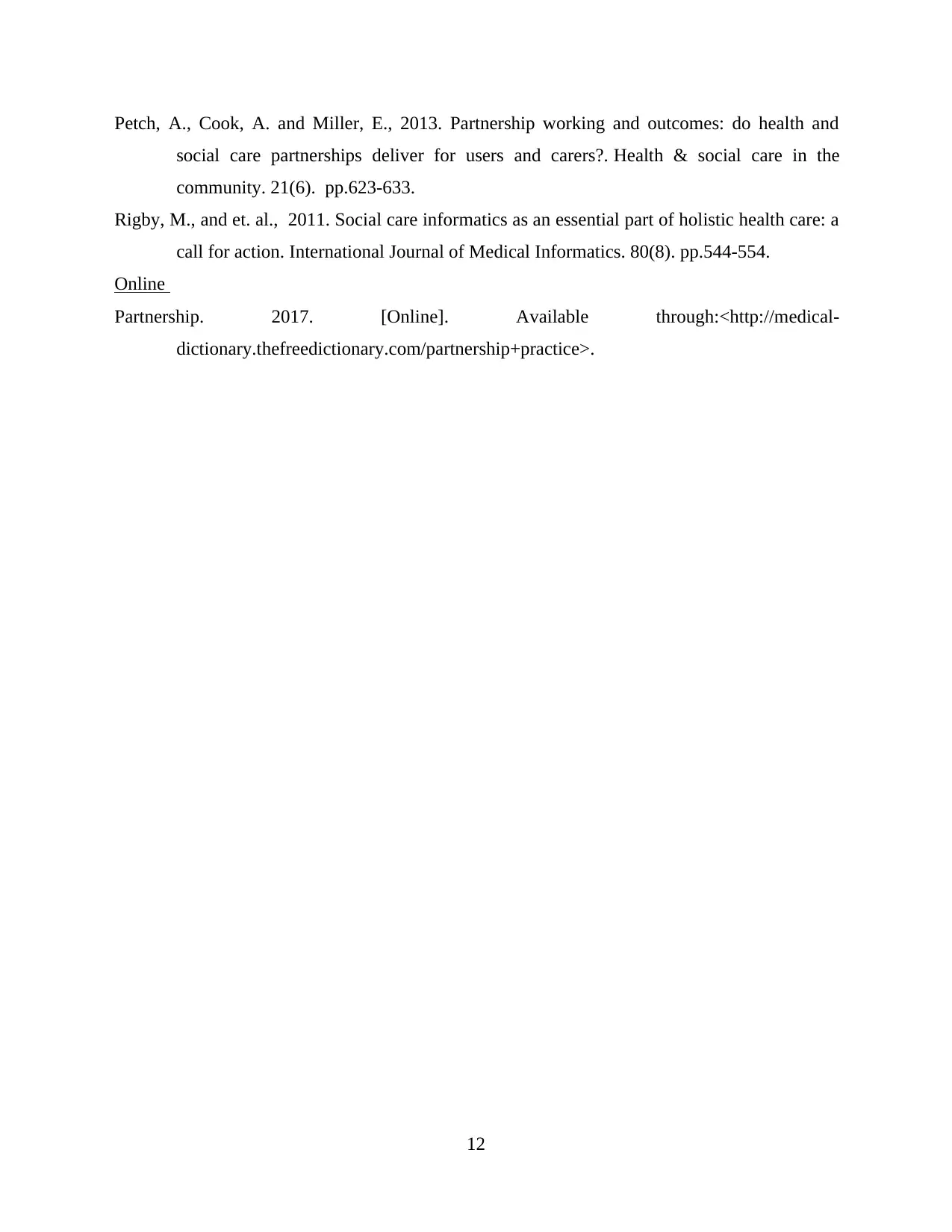
Petch, A., Cook, A. and Miller, E., 2013. Partnership working and outcomes: do health and
social care partnerships deliver for users and carers?. Health & social care in the
community. 21(6). pp.623-633.
Rigby, M., and et. al., 2011. Social care informatics as an essential part of holistic health care: a
call for action. International Journal of Medical Informatics. 80(8). pp.544-554.
Online
Partnership. 2017. [Online]. Available through:<http://medical-
dictionary.thefreedictionary.com/partnership+practice>.
12
social care partnerships deliver for users and carers?. Health & social care in the
community. 21(6). pp.623-633.
Rigby, M., and et. al., 2011. Social care informatics as an essential part of holistic health care: a
call for action. International Journal of Medical Informatics. 80(8). pp.544-554.
Online
Partnership. 2017. [Online]. Available through:<http://medical-
dictionary.thefreedictionary.com/partnership+practice>.
12
1 out of 14
Related Documents
Your All-in-One AI-Powered Toolkit for Academic Success.
+13062052269
info@desklib.com
Available 24*7 on WhatsApp / Email
![[object Object]](/_next/static/media/star-bottom.7253800d.svg)
Unlock your academic potential
© 2024 | Zucol Services PVT LTD | All rights reserved.





